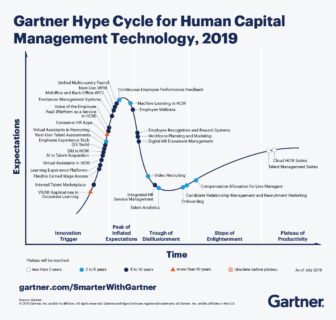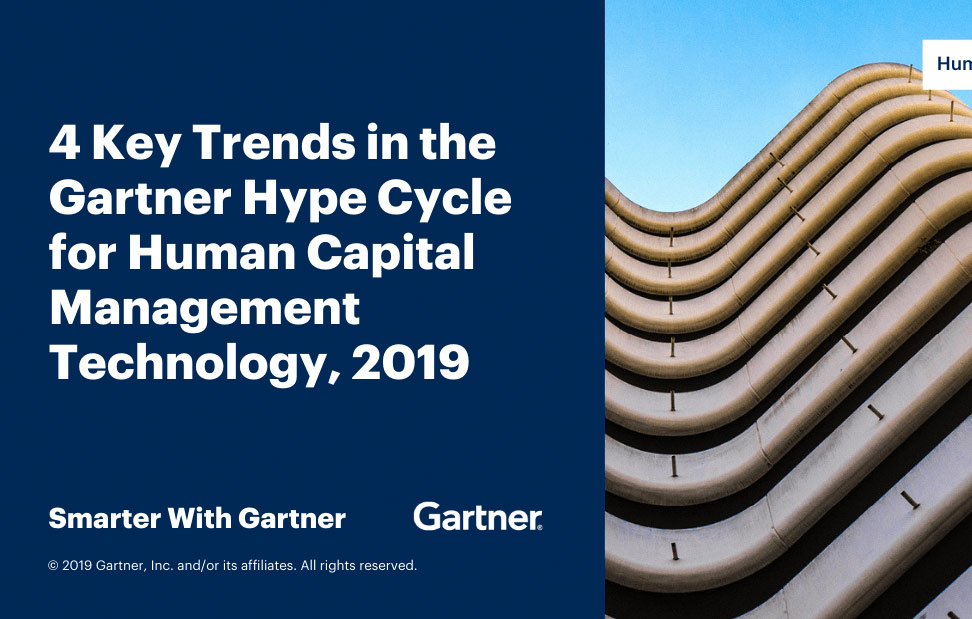Emerging human capital management (HCM) technologies will help HR overcome challenges around stakeholder engagement and talent acquisition and management.
Employee engagement and productivity are key priorities for organizations globally in today’s hypercompetitive labor markets, and designers of HCM applications are thus increasingly aiming to improve the candidate, worker and manager experiences, the Gartner Hype Cycle for Human Capital Management Technology, 2019, shows.
At the same time, continuous learning, listening, feedback and performance management are needed to sustain digital business and to thrive, despite the “turns” and disruption that organizations increasingly face.
The technologies featured in this Hype Cycle reflect this narrative, as well as more developed trends within the HCM market, such as the maturation of talent management and HCM suites.
“By 2022, 50% of large enterprises will have invested in a major initiative to improve their manager experience by automating multiple work-related HCM tasks”
“The 2019 HCM Hype Cycle highlights emerging technologies that will have a significant impact on administrative HR, talent management, workforce management, and integrated HR service management in coming years,” says Gartner VP Analyst Ron Hanscome.
The Hype Cycle can help HR leaders prioritize investment by providing insight into the maturity of important technologies and concepts. Among the 30 innovations profiled, Gartner clients are focusing their attention on four key areas.

Automation of the manager experience
By 2022, 50% of large enterprises will have invested in a major initiative to improve their manager experience by automating multiple work-related HCM tasks. Importantly, these technologies are meant to reduce the amount of time managers spend on administrative tasks, not replace managers’ role/authority by automation.
One example is workforce management (WFM), a suite of functions designed to help manage hourly paid workers. Core functions of WFM include time and attendance, scheduling, absence management and task management.
Next-generation (next-gen) WFM is the result of the following trends impacting the market: automation of the manager experience; employee experience; virtual assistants (VAs); new platforms; the flexible workforce.
“While the potential benefit of next-gen WFM is high, mainstream adoption is still 5-10 years away, and the technology is nearing the Peak of Inflated Expectations”
Next-gen WFM offers the ability to both augment and transform existing business processes for organizations with hourly paid workers. Properly executed, the benefits include improved employee engagement, reduced manager time spent on administrative tasks, improved usability of the WFM application, reduced cost of training, and easier management of employees and contingent workers.
While the potential benefit of next-gen WFM is high, mainstream adoption is still 5-10 years away, and the technology is nearing the Peak of Inflated Expectations on the Hype Cycle — a period during which publicity produces a number of success stories, often accompanied by scores of failures. Some companies take action; many do not.
Still, given the potential benefits, any application leader responsible for HCM, and senior HR leaders in organizations with hourly or shift-based workers, should place a high priority on creating a strategy around next-gen WFM.
Voice of the employee (VoE)
By 2020, 20% of organizations will include employee engagement improvement as a shared performance for HR and IT groups. To measure and monitor employee engagement, an increasing number of organizations are using engagement data beyond formal large-scale surveys to create a more holistic “voice of the employee.”
VoE technologies, such as employee sentiment and social analytics tools, collect and analyze opinions, perceptions and feelings of employees and workers, providing a way to harness multiple sources of information to understand the dynamics of the employee experience; they are not meant to enable covert surveillance of employees.
“By 2022, 35% of organizations will utilize conversational user experience and natural language processing interactions in their talent acquisition”
Gartner positioned VoE quite early in the Hype Cycle in 2017, but few VoE solutions in 2019 can yet be called “comprehensive” as most still fail to deliver all the needed data collection and analytical methods. Also, the market has yet to coalesce around a more standardized set of capabilities for VoE processes, enabling technologies and services. VoE needs more time (at least five years) to mature to reach widespread adoption.
Nevertheless, the potential benefit is high, and over the longer term, a VoE approach can contribute to improving an organization’s overall employee experience and employment value proposition. Potential employees are more likely to be attracted to a work environment in which their voice is heard. VoE also has the potential to improve engagement, performance and productivity among existing employees over time.
Analytics and AI in talent acquisition
By 2022, 35% of organizations will utilize conversational user experience and natural language processing interactions in their talent acquisition, which will turn the job application process into a simple conversation.
Artificial intelligence (AI) in talent acquisition is on the rise in the Hype Cycle, and the potential benefit is high. Gartner research shows steady demand from organizations to leverage these technologies, including capabilities across front-end talent processes such as sourcing, job targeting and distribution, and predictive analytics to improve time-to-hire and quality-of-hire metrics. A variety of “point” solutions are available, including chatbots, VAs and AI-enabled sources.
“VAs can also be deployed to improve a team’s search proficiency with AI, as well as potentially to overcome biases”
AI apps and chatbots support the operational side of talent software used by recruiters and candidates in the application process. Early adopters used these tools to support recruiters dealing with high-volume, high-transactional activities early in the recruitment process. As interest grows and the market matures, solutions are moving deeper into the hiring process to support both recruiters and applicants in more advanced activities.
By expanding sourcing and screening capacity, as well as increasing levels of initial front-line responsiveness, talent acquisition teams can gain a broader reach and higher levels of candidate interaction. VAs can also be deployed to improve a team’s search proficiency with AI, as well as potentially to overcome biases. By increasing efficiency, an AI-supported recruitment process can also help the recruitment team to focus on the right talent at the right time.
Rise of the internal talent marketplace
The gig economy and the need for business agility have opened up new ways of working, challenging established notions of employment and changing worker expectations, and preferences around how individuals manage their careers and build their portfolio of work experiences.
Marketplace-based platforms make it much easier to connect customers directly to suppliers. Internal talent marketplaces take advantage of the increased flexibility of the gig economy and marketplace-based platforms without requiring changes to employment categories. They match internal employees and, in some cases, a pool of contingent workers, to short-term project and work opportunities without recruiter involvement.
The internal talent marketplace is embryonic on the Hype Cycle, but the benefit is potentially transformational, enabling tomorrow’s more lean, agile and adaptive organizations.
Large enterprises looking to push innovation to the edge can be encumbered by heavy management and control structures. Internal talent marketplaces have the potential to change that. They establish trust through feedback mechanisms. They enable worker-led innovation and contribute to workers fully taking control of their own careers. They mean much better and more granular tracking of skills, competencies, knowledge and interest of individual workers — in turn allowing enterprises to have a much better view into their workforce and improve workforce planning.
Source: by Jackie Wiles on October 25, 2019 – https://www.gartner.com/smarterwithgartner/4-key-trends-gartner-hype-cycle-human-capital-management-technology-2019

